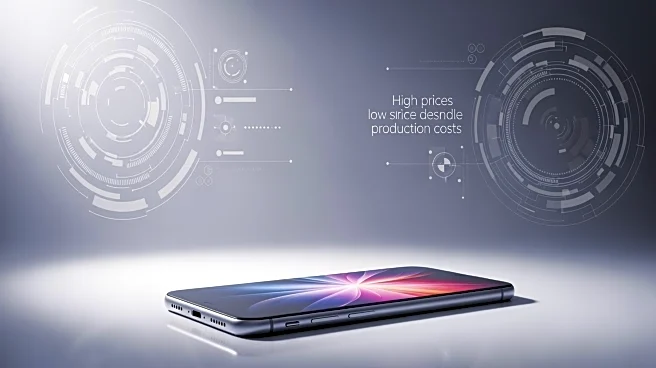What's Happening?
The global smartphone market in 2025 is under scrutiny for maintaining high retail prices despite low production costs. A market review reveals that flagship smartphones, such as those from Apple and Samsung,
have significant profit margins, with production costs far below retail prices. For instance, the cost to produce an iPhone is estimated between $350 and $450, yet it retails for around $1,200. This discrepancy is attributed to aggressive marketing strategies rather than actual production expenses. In the U.S., entry-level smartphones are available for as little as $20 to $50, highlighting the stark contrast in pricing strategies. The depreciation of flagship models is also notable, with devices like the Samsung Galaxy S24 Plus losing up to 50% of their value within a year.
Why It's Important?
This pricing strategy has significant implications for consumers and the broader tech industry. Consumers are increasingly aware of the inflated prices and are opting to keep their devices longer, impacting sales of new models. The high profit margins suggest that companies prioritize marketing over innovation, potentially stifling technological advancement. This could lead to a shift in consumer behavior, with more people choosing affordable or refurbished models, thereby affecting the sales of high-end devices. The situation also raises questions about the ethical implications of such pricing strategies, as smartphones have become essential tools in modern life.
What's Next?
As consumers become more informed about the true costs of smartphones, there may be increased demand for transparency in pricing. This could pressure manufacturers to adjust their pricing strategies or risk losing market share to more affordable brands. Additionally, regulatory bodies might step in to ensure fair pricing practices in the tech industry. The trend of consumers holding onto their devices longer could also lead to a rise in the market for refurbished phones, further challenging the dominance of flagship models.
Beyond the Headlines
The current pricing model of smartphones reflects broader issues in consumer culture and corporate ethics. The reliance on marketing to justify high prices highlights a disconnect between consumer needs and corporate strategies. As smartphones are integral to daily life, the industry may face increased scrutiny over its pricing practices, potentially leading to a reevaluation of how technology is valued and sold. This could also spark a broader conversation about the role of consumerism in technology and the responsibility of companies to provide fair value.












